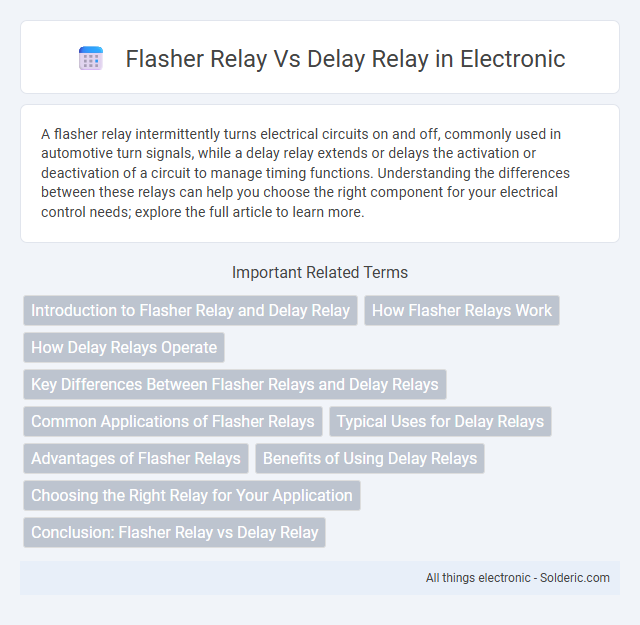A flasher relay intermittently turns electrical circuits on and off, commonly used in automotive turn signals, while a delay relay extends or delays the activation or deactivation of a circuit to manage timing functions. Understanding the differences between these relays can help you choose the right component for your electrical control needs; explore the full article to learn more.
Comparison Table
| Feature | Flasher Relay | Delay Relay |
|---|---|---|
| Function | Generates intermittent ON/OFF signals to flash lights | Provides delayed switching after a trigger |
| Application | Vehicle indicators, warning signals | Lighting control, motor start delay, HVAC systems |
| Operation | Continuous cyclic switching at set intervals | Single delay period before activation or deactivation |
| Timing Control | Fixed or adjustable flash rate | Adjustable delay time (seconds to minutes) |
| Output Type | Intermittent output waveform | Steady output after delay |
| Typical Voltage | 12V to 24V DC (automotive) | Varies widely: 12V DC to 240V AC |
| Use Case Example | Turn signal lights | Fan startup delay |
Introduction to Flasher Relay and Delay Relay
Flasher relays and delay relays are essential components in electrical circuits, serving distinct timing functions. A flasher relay controls the periodic on-off cycling of lights, commonly used in automotive turn signals and warning lights. Delay relays, on the other hand, introduce a time lag before activating or deactivating a circuit, optimizing your equipment's performance by managing timed operations precisely.
How Flasher Relays Work
Flasher relays operate by intermittently interrupting the electrical current to vehicle indicator lights, producing a blinking effect essential for signaling turns or hazards. These relays use a bimetallic strip or electronic timer to heat up and cool down, causing the circuit to open and close cyclically at a consistent rate. Unlike delay relays that hold a circuit open or closed for a preset time, flasher relays specifically create repetitive on-off cycles to enhance vehicle visibility and safety.
How Delay Relays Operate
Delay relays operate by allowing electrical current to pass through their contacts only after a preset time interval has elapsed, creating a controlled delay in the circuit activation or deactivation. These relays use internal timing mechanisms such as resistors, capacitors, or microcontrollers to regulate the delay period, which can be adjusted based on application requirements. Unlike flasher relays that produce an intermittent on-off signal, delay relays provide a steady output after the time delay, enhancing precise control in automation systems and lighting circuits.
Key Differences Between Flasher Relays and Delay Relays
Flasher relays are designed to intermittently break and restore electrical circuits, commonly used in automotive turn signal systems to create a blinking effect. Delay relays control the timing of circuit activation or deactivation by introducing a set time delay before switching, often utilized in industrial automation for precise process control. The key difference lies in functionality: flasher relays provide repetitive on-off cycles, while delay relays offer a single time-controlled switching event.
Common Applications of Flasher Relays
Flasher relays are commonly used in automotive turn signal systems to create the blinking effect necessary for indicator lights. They also find applications in emergency vehicle lighting and HVAC systems for controlling cyclic operations of alarms or fans. Their simple on-off cycling makes them essential in any circuit requiring periodic flashing signals.
Typical Uses for Delay Relays
Delay relays are commonly used in industrial automation, HVAC systems, and lighting controls to manage the timing of electrical circuits by introducing a preset delay before activation or deactivation. These devices help protect equipment by ensuring proper sequencing and preventing short cycling, which can extend the lifespan of motors and compressors. Your control system benefits from delay relays for precise timing functions such as motor start/stop delays, fan control, and timed lighting operations.
Advantages of Flasher Relays
Flasher relays offer advantages such as simple installation, lower cost, and reliable operation in automotive and signaling systems by providing consistent blinking of lights without complex electronic components. Their mechanical or solid-state designs ensure durability and ease of maintenance, reducing the likelihood of failure in demanding environments. Flasher relays also improve safety by ensuring clear, rhythmic light signals essential for indicators and warning lights.
Benefits of Using Delay Relays
Delay relays provide precise control over timing functions in electrical circuits, enhancing the reliability and efficiency of your systems. They prevent damage caused by sudden current surges by allowing gradual activation or deactivation of components, thus extending the lifespan of connected devices. Using delay relays reduces maintenance costs and improves overall operational stability compared to flasher relays, which primarily focus on intermittent signaling rather than timed control.
Choosing the Right Relay for Your Application
Flasher relays are ideal for automotive and signaling applications where intermittent on-off cycling is required, providing reliable blinking control for indicator lights and hazards. Delay relays suit industrial and automation systems needing timed operations, enabling precise control over activation and deactivation intervals to prevent machinery damage or process errors. Selecting the right relay depends on whether your application demands timed delay functions or repetitive flashing signals to ensure optimal performance and system safety.
Conclusion: Flasher Relay vs Delay Relay
Flasher relays are designed to create intermittent on-off signals essential for applications like turn signals, offering rapid switching to indicate alerts. Delay relays provide timed control by maintaining or interrupting current flow after a set duration, enabling functions such as lighting or motor control with precise timing. Choosing between flasher and delay relays depends on whether intermittent flashing or timed output is required for the specific electrical circuit.
Flasher relay vs delay relay Infographic

 solderic.com
solderic.com